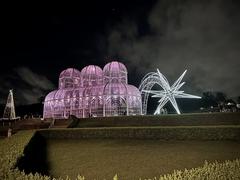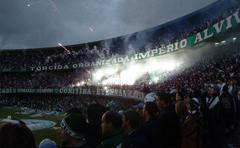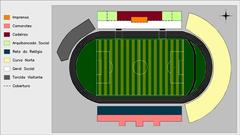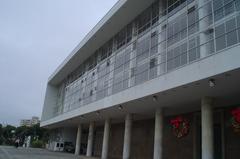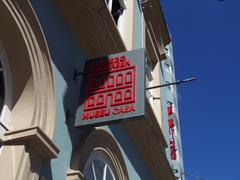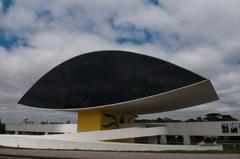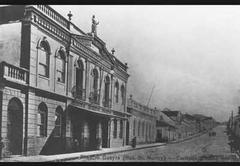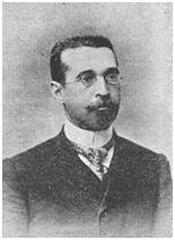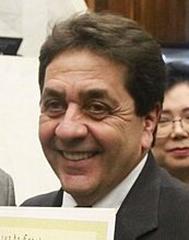Rodoferroviária de Curitiba: Visiting Hours, Tickets, and Historical Sites Guide
Date: 04/07/2025
Introduction
Situated in the vibrant Jardim Botânico neighborhood, the Rodoferroviária de Curitiba is much more than a transport terminal—it’s a landmark blending historical significance, modernist architecture, and sustainable urban mobility. As the main intermodal hub of Curitiba, it connects local, regional, and international bus and rail routes, welcoming nearly one million passengers each month. Designed by renowned modernist architect Rubens Meister and inaugurated in 1972, the complex embodies the city’s pioneering efforts in integrated public transportation and innovative urban planning (Wikipedia; URBS; Paraná Histórica; ICLEI Case Study).
Beyond its transit role, the Rodoferroviária offers a wide range of amenities, is a showcase of Brazilian modernism, and stands as a global example of sustainable, inclusive urban development. This guide covers visiting hours, ticketing, facilities, travel tips, nearby attractions, and the terminal’s architectural and environmental impact.
Table of Contents
- Introduction
- Historical Overview and Architectural Significance
- Visitor Information
- Terminal Layout and Facilities
- Bus Operations and Tickets
- Rail Operations and Tourist Experience
- Urban Transport Integration
- Real-Time Information and Passenger Services
- Nearby Attractions and Special Events
- Operational Efficiency and Urban Mobility Significance
- Practical Tips for Seamless Transfers
- Sustainability at Rodoferroviária de Curitiba
- Challenges Facing Rodoferroviária de Curitiba
- Urban Impact of Rodoferroviária de Curitiba
- FAQ
- Conclusion and Recommendations
- References
Historical Overview and Architectural Significance
Early History of the Site
The terminal stands on land pivotal to Curitiba’s urban evolution. In the early 1900s, it was the site of the Usina Elétrica do Capanema, a thermoelectric plant built by José Hauer. By 1913, this location served as the departure point for Curitiba’s first electric trams, anchoring the city’s public transport history (Wikipedia; Curitiba Histórica). In the mid-20th century, the federal government acquired the land for Rede Ferroviária Federal S.A. (RFFSA) workshops and staff housing, cementing its role in Curitiba’s transport infrastructure.
Conception and Construction
With post-war growth straining the old bus terminal at Terminal do Guadalupe, city planners sought a modern intermodal solution. The municipality received the land in the early 1970s, commissioning Rubens Meister to design a terminal integrating bus and rail in a modernist style. Opened on November 13, 1972, the Rodoferroviária was built by Construtora Pussoli Ltda, strategically located on Avenida Presidente Affonso Camargo (Paraná Histórica).
Architectural Significance
The terminal embodies Brazilian modernism: clean lines, functional spaces, and prominent use of reinforced concrete. It consists of three wings (federal, state, railway) and a central cubic building, with 50 platforms and a dedicated rail section. Its integration of bus and train services was pioneering for Brazil (CAC Arquitetura; Wikipedia).
Infrastructure and Amenities
From its inception, the terminal offered an array of services: snack bars, restaurants, lottery outlets, police stations, newsstands, gift shops, and more—spread over 72,160 m², including 10,000 m² of green spaces (Paraná Histórica).
Urban and Cultural Impact
The Rodoferroviária decentralized Curitiba’s transit, easing downtown congestion and setting a precedent for public infrastructure. Its robust, open structure—praised by architects—reflects ideals of accessibility and efficiency (EAA Architecture Guide; Circulando por Curitiba).
Evolution and Modernization
The terminal has grown into one of southern Brazil’s busiest, serving 930,000 passengers monthly as of 2009 (Wikipedia). Managed by URBS, with tourist rail operated by Serra Verde Express, it underwent major renovations ahead of the 2014 FIFA World Cup—improving accessibility, security, and passenger facilities.
Visitor Information
Location and Accessibility
Located at Avenida Presidente Affonso Camargo, Jardim Botânico, the terminal is easily reached by public transport (including BRT), taxis, ride-sharing, and nearby cycle paths (URBS).
Visiting Hours
- Terminal: 24 hours a day, 365 days a year.
- Shops/Services: Generally 6:00 AM – 10:00 PM; hours may vary.
Tickets and Services
- Bus Tickets: Available at terminal counters or online via company websites and apps (Rodoviária Curitiba).
- Train Tickets: Serra Verde Express tickets can be booked online (Serra Verde Express) or onsite.
- Accessibility: Wheelchair accessible with ramps, elevators, adapted restrooms, and trained assistants (Busca Ônibus).
- Left Luggage: Secure automated storage available.
Travel Tips
- Arrive 30 minutes before departure, especially during peak periods.
- Use official counters or trusted apps for ticketing.
- Keep valuables secure and use left-luggage for convenience.
Nearby Attractions
- Jardim Botânico: Iconic botanical garden nearby.
- Museu Oscar Niemeyer: Celebrated museum of modern art and architecture.
- Mercado Municipal: Vibrant local market.
- Parque Barigui: Expansive city park ideal for relaxation.
Terminal Layout and Facilities
The complex includes 50 commercial stores and eight kiosks: eateries, cafés, fruit shops, post office, pharmacy, ATMs, tourist desk, showers, hair salon, bookstores, and regional goods shops (URBS). Security is provided by police and URBS staff. Accessibility features are prominent throughout.
Bus Operations and Tickets
Serving 35 bus companies on 140 lines, the terminal connects to 100+ cities and international destinations like Buenos Aires and Paraguay (Clube do Ônibus; Visite Curitiba). Tickets are available online and onsite, with payment via card or Pix.
Rail Operations and Tourist Experience
The railway station, adjacent to the bus terminal, is the departure point for the Serra Verde Express tourist train to Morretes, traversing the Serra do Mar and Atlantic Forest (Lonely Planet). The route features vintage carriages and scenic views. Regular passenger rail is limited to tourist routes; freight is managed by Rumo Logística.
Urban Transport Integration
The terminal is a hub in Curitiba’s acclaimed BRT system, with multiple urban bus lines, express (Ligeirinho), inter-neighborhood, and tourist buses stopping nearby (URBS). Taxi, ride-share, and car rentals are also available.
Real-Time Information and Passenger Services
Digital displays and online platforms provide up-to-date departure info (CheckMyBus). Lost and found, tourist information, and left-luggage services are available (Clube do Ônibus; Visite Curitiba).
Nearby Attractions and Special Events
The terminal is steps from top attractions—Jardim Botânico, Mercado Municipal, museums, and parks. The area hosts cultural events and offers ample opportunities for architectural and urban photography (Clube do Ônibus).
Operational Efficiency and Urban Mobility Significance
Rodoferroviária exemplifies Curitiba’s sustainable mobility, supporting transit-oriented development and reducing car use (ICLEI). Its high capacity, strategic location, and integration with the BRT system make it a model for urban transport globally (URBS).
Practical Tips for Seamless Transfers
- Arrive early, especially during peak periods (Clube do Ônibus).
- Use BRT and urban buses for affordable, fast access.
- Check real-time schedules online or at the terminal.
- Ask staff for accessibility or travel assistance.
- Secure luggage using left-luggage services.
- Most payments are accepted via card or Pix (Rodoviária Curitiba).
Sustainability at Rodoferroviária de Curitiba
Integration with Urban Planning
As a core of Curitiba’s transit-oriented development since the 1970s, the terminal connects long-distance buses, regional trains, and the BRT, supporting reduced emissions and congestion (ICLEI Case Study).
Energy and Green Initiatives
Energy-efficient lighting, waste separation, and water-saving fixtures are standard. Public recycling programs achieve rates up to 70% (Green Matters; World Future Energy Summit).
Promoting Active and Shared Mobility
The terminal links directly to Curitiba’s bike-sharing system (Tembici) and cycle paths, encouraging active transport and aiming to reduce car dependency (Renovables Verdes).
Social Inclusion
Accessibility features abound, and programs like “Green Change” let citizens exchange recyclables for food or bus tokens (Renovables Verdes).
Challenges Facing Rodoferroviária de Curitiba
- Congestion: Rapid population growth increases peak-hour crowding (Renovables Verdes).
- Maintenance: Ongoing updates are needed for aging infrastructure (ICLEI Case Study).
- Social Equity and Security: Informal economies and petty crime in surrounding areas require enhanced security and social programs (Green Mochila).
- Environmental Pressures: Pollution and heat islands are being addressed by electrifying bus fleets (Renovables Verdes).
- Equity in Transit: Peripheral neighborhoods benefit less from TOD investment, raising equity concerns (Urban Demographics).
Urban Impact
- Urban Form: The terminal anchors linear growth, mixed-use neighborhoods, and up to 50% car-use reduction in key corridors (ICLEI Case Study).
- Economic Integration: Supports local businesses and affordable mobility, enhancing inclusion (Green Mochila).
- Global Influence: Curitiba’s BRT and terminal model inspire cities worldwide (PMI Project Management Institute).
- Quality of Life: Active transport, green spaces, and public transit enhance urban biodiversity and well-being (World Future Energy Summit).
Frequently Asked Questions (FAQ)
Q: What are the visiting hours?
A: The terminal is open 24/7, year-round; most shops operate 6:00 AM–10:00 PM.
Q: Where can I buy tickets?
A: At terminal counters or online via official company websites.
Q: How do I reach nearby attractions?
A: Use BRT, bike-share, or taxis to access sites like Jardim Botânico, Mercado Municipal, and major museums.
Q: Is the terminal accessible?
A: Yes—ramps, elevators, adapted restrooms, and staff assistance are available.
Q: What sustainability programs exist?
A: Recycling initiatives, energy efficiency, and social programs like Green Change.
Conclusion and Recommendations
The Rodoferroviária de Curitiba is a living symbol of Curitiba’s integration of history, innovation, and sustainability. Its modernist architecture, comprehensive services, and role in urban development set a global benchmark for transit-oriented cities. Whether you’re traveling, exploring architecture, or studying urban planning, the terminal offers a unique window into Curitiba’s legacy and future.
For a seamless experience, use digital resources like the Audiala app for real-time updates, ticketing, and guided tours. Take time to explore nearby attractions, and enjoy Curitiba’s vibrant cultural and urban landscape.
References
- Wikipedia
- URBS
- Paraná Histórica
- ICLEI Case Study
- Green Matters
- Curitiba Histórica
- World Future Energy Summit
- CAC Arquitetura
- EAA Architecture Guide
- Circulando por Curitiba
- Lonely Planet
- Clube do Ônibus
- Visite Curitiba
- Rodoviária Curitiba
- Busca Ônibus
- CheckMyBus
- Renovables Verdes
- Green Mochila
- Urban Demographics
- PMI Project Management Institute

